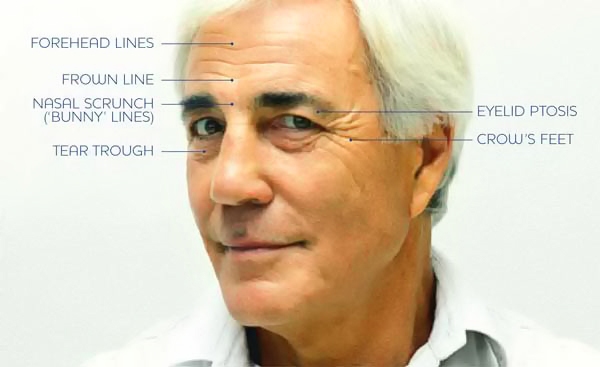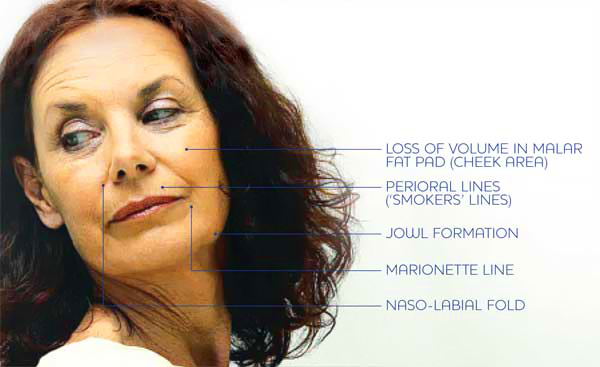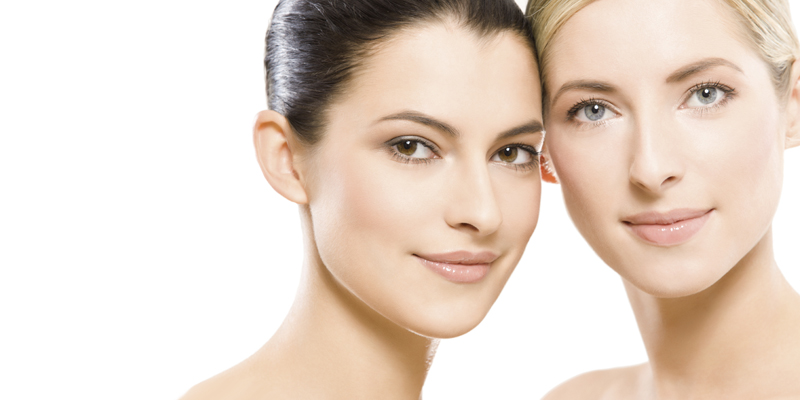 Ageing Face
Ageing Face
Most of us judge human beauty by assessing people's faces. From birth to old age the facial canvas changes, although you inherit your features and they are in turn affected by numerous environmental factors such as sun, conditioning, lifestyle, exposure, smoking, pollution
and movement.
The ageing process can be accelerated if an unbalanced situation exists between yourself and your environment and we can sometimes tell when looking at facial features what a person has been up to. By understanding the way the face ages or changes we can choose the best and safest therapies to correct or reverse the signs of ageing.
Key areas of ageing for males:
 |
Key areas of ageing for females:
 |
There are two types of skin ageing: intrinsic and extrinsic
Intrinsic ageing is genetically programmed and occurs all over the body. The skin becomes thinner, drier and slower to regenerate. It is not possible to delay this process.
Extrinsic ageing occurs when the skin is exposed to direct ultraviolet [sun] radiation and is 90% responsible for the cosmetic changes to our skin. Loss of collagen and elastin causing loss of volume, development of pigmentation and irregular thickening of the skin surface can all occur. The end result is a poor, unhealthy looking complexion with a rough texture, mottled pigmentation, wrinkling, loose skin and broken blood vessels. We must remember at all times that the sun is our greatest enemy and we must protect ourselves to prevent serious damage. When UV hits the skin its rays trigger the production of free radicals which damage healthy skin cells. It can also produce excessive amounts of melanin, responsible for pigmentation, which can appear as sun or age spots. If pigmentation is already pre-existing, it can be exacerbated.
Another extrinsic factor waging war on our skin is cigarettes. If you are a fag-smoking sun-worshipper your skin has probably seen better days. Smoking causes vasoconstriction which restricts blood flow to the skin surface. Pollution contributes to skin damage - working in a metropolis and regularly commuting will expose you to more pollution. Preventative steps include using a good cleanser twice daily and applying skin barrier protection cream (sun protection factor SPF 30+) to inhibit the penetration of pollution chemicals.
As a person ages the surface layer of the skin (epidermal cells) become thinner. The barrier function of the skin develops faults allowing moisture to escape instead of being kept in the skin, consequently causing dryness. The total number of epidermal cells decreases by 10% per decade and turn over more slowly as we age making the skin less able to repair itself.
The deeper layer of the skin (dermis) becomes thinner and less collagen is produced. The elastin fibres that provide elasticity wear out, resulting in wrinkling and sagging. Sebaceous glands enlarge and produce less sebum whilst the number of sweat glands decrease, compounding the dryness problem.
In the subcutaneous layer (deeper than the dermis) the fat cells shrink with age, at this point wrinkling becomes more noticeable because the fat cells cannot "fill in" the damage from the other layers.
On the face, the thinner and less elastic skin tends to sag and fold. Permanent crease lines and crow's feet form on the brow and around the eyes. The eyebrows drop, and loose skin folds around the upper and lower eyelids. Tiny wrinkles form around the lips. The tissues of the jaw and neck droop into jowls and double chins. The skin of the neck droops into folds and wattles. However medical aesthetic treatments can provide a glimmer of hope in the quest for anti-ageing.







